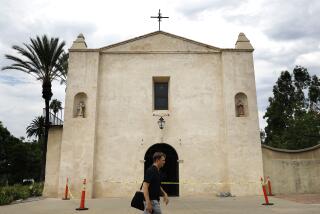Mission Officials Fire Archeologists Working on School Project
VENTURA — Church officials at historic San Buenaventura Mission on Thursday fired a team of archeologists who have been excavating the church grounds as part of a $5.5-million expansion of aging Holy Cross School.
The decision follows claims by dig director Gary Stickel and archeologist Robert Dunn that church officials have pressured them to do shabby work in an effort to build the school as quickly and cheaply as possible.
Msgr. Patrick J. O’Brien on Thursday said only that church officials have decided to go with a different archeological firm for the construction phase of the project.
He would not discuss the dispute with Stickel and his team of nine archeologists hired to excavate the spots where building columns will be set 50 feet deep into the artifact-rich soil.
“The past is over,” O’Brien said. “I don’t wish to open up all that went down in the last weeks. Let’s let sleeping dogs lie.”
Church officials have previously maintained that the historic artifacts buried in the layers of clay beneath the site have been properly cared for and that all legal requirements have been met.
Dunn, however, disagrees.
The archeologist says the site is significant in that it could shed light on how Chumash Indians were treated by missionaries in the early 1800s.
On Thursday, Dunn called on the State Office of Historic Preservation to investigate damage constituting legal violations at the nationally registered historic site.
He charged that city officials will not allow him to make slide presentations to the city’s historical preservation committee. The presentation, he said, would depict sensitive areas, including one near a Chumash burial area, that he alleges were bulldozed.
But city officials said committee members have already toured the site and are satisfied with the work done there. And the city released a letter dated Sept. 25 in which Stickel stated that the first portion of the archeological project had been successfully completed.
Stickel could not be reached for comment Thursday.
State law requires that archeologists and a Native American consultant document any artifacts that are discovered prior to a construction project and monitor the construction.
In two months of work, ancient shells, glass beads and smoking pipes were unearthed.
But most significant to the archeologists, Dunn said, was the refuse--bones and other organic garbage--that was shedding light on the Chumash people’s change from a marine- to cattle-based diet following arrival of the missionaries.
Details about the Chumash diet in the early 1800s could have dispelled or confirmed a long-brewing controversy over the missionaries’ treatment of Native Americans, Dunn said.
More to Read
Sign up for Essential California
The most important California stories and recommendations in your inbox every morning.
You may occasionally receive promotional content from the Los Angeles Times.










